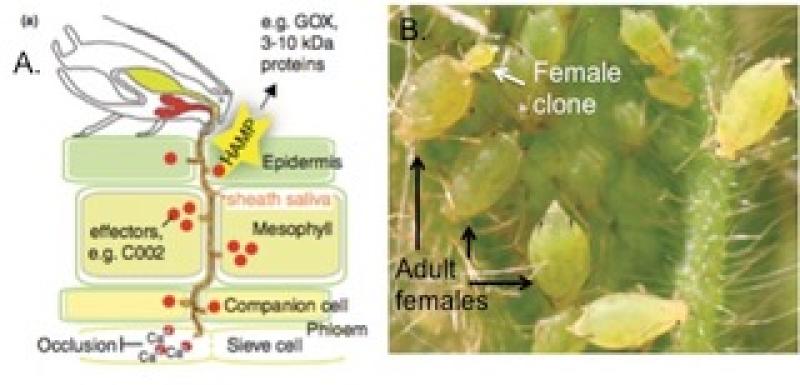Exploiting the soybean aphid's genome to help develop aphid management strategies

Aphids are small insects that have a stylet (a piercing-sucking mouthpart) that acts as a straw and allows them to feed from plant sap (Figure 1A). Many species reproduce asexually, or clonally during part of their life cycle, allowing populations to expand rapidly (Figure 1B).

Figure 1: A). The aphid's stylet must migrate between plant cells to feed from the sap. Image (1). B). An adult female gives birth to an aphid nymph. Image from (2).
As aphids feed from plant sap and multiply quickly, those that feed on crops reduce yield and can be costly for farmers to manage. The soybean aphid (Aphis glycines, Figure 2) is an important pest of soybean, capable of causing up to 40% yield loss (3) and $2.4 billion dollars annually in damage (4).
Figure 2. A) Soybean aphids (winged and wingless) feeding on soybean. Note that there can be hundreds of aphids feeding on each leaf. B) Wingless form of the soybean aphid. C) Winged form of the soybean aphid.
The soybean aphid can be managed in the field using insecticides or host-plant resistance, which are soybean varieties that are resistant to the aphid. These aphid-resistant soybean varieties keep aphid populations low and are environmentally safe. However, there are resistance-breaking aphids in the field that can survive on the resistant soybean varieties, threatening their durability as a pest management option.
Dr. Andy Michel's laboratory is working to understand how aphids can overcome aphid-resistant soybean. We have recently published the genome sequence of the aphid (5), which can help us find the molecular mechanism aphids use for overcoming resistance. For example, we can look for DNA sequences that are present only in resistance-breaking aphids. We can also examine how expression of genes changes in resistance-breaking aphids, and use our genome to predict what those genes are doing and how they could be contributing to aphid survival.
Once we have identifies the molecular mechanisms that enable aphids to overcome host-plant resistance, breeders can use this information to breed soybean varieties with other mechanisms of resistance against the aphid. Overall, the genome project helps ensure that aphid-resistant soybean varieties are a promising option for aphid management.
We can also use the genome sequence to study the mechanism for insecticide resistance in aphids, which is a problem that has been reported for growers in some areas of the Midwest. Finally, the genome is a useful tool to study broad aspects of the aphid's biology, such as their extreme host specialization (soybean aphids feed only on soybean and overwinter on buckthorn). We can also use the genome to study the aphid's interaction with its endosymbionts, which are bacteria that live within the aphis and supplement the aphid's diet with essential nutrients.
The availability of the aphid's genome helps us better understand the biology of this pest, and is an important tool as we develop novel pest management strategies.
The funding for the genome sequencing project was provided by the North Central Soybean Research Program (NCSRP), the USDA National Institute of Food and Agriculture, the Ohio Soybean Council and the Center for Applied Plant Sciences (CAPS) at The Ohio State University.
References:
1) Hogenhout, S. A. and J. I. B. Bos. 2011. Effector proteins that modulate plant-insect interactions. Curr. Opin. Plant Biol. 14: 422-428.
2) Tilmon, K. J., E. W. Hodgson, M.E. O'Neal, and D. W. Ragsdale. 2011. Biology of the Soybean Aphid, Aphis glycines (Hemiptera: Aphididae) in the United States. J. Integr. Pest Manag. 2: 1-7.
3) Ragsdale, D. W., B.P. McCornack, R.C. Venette, B. D. Potter, I. V. MacRae, E. W. Hodgson, M. E. O'Neal, K. D. Johnson, R. J. O'Neal, C. D. DiFonzo, T.E. Hunt, P. A. Glogoza, and E. M. Cullen. 2007. Economic threshold for soybean aphid (Hemiptera: Ahididae). J. Econ. Entomol. 100: 1258-1267.
4) Song, F. S., M. Swinton, C. DiFonzo, M. O'Neal, and D.W. Ragsdale. 2006. Profitability analysis of soybean aphid control treatments in three north-central states. Michigan State University Department of Agricultural Economics. Staff Paper. 2006-24.
5) Wenger, J. A., B. J. Cassone, F. Legeai, J. S. Johnston, R. Bansal, A. D. Yates, B. S. Coates, V. A. C. Pavinato, and A. Michel. 2017. Whole genome sequence of the soybean aphid, Aphis glycines. Insect Biochem. Mol. Biol.
Written by TPS Fellow, Ashley Yates
